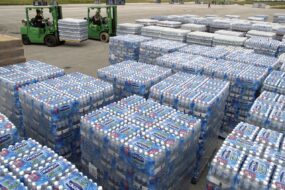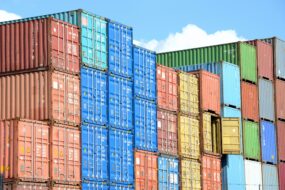Contents

Two popular types of containers are floor-loaded and pallet-loaded containers. While both are designed to transport cargo, there are significant differences between the two that should be understood in order to select the appropriate container for your needs.
In this post, we will discuss the differences between floor-loaded and palletized containers, and the factors to consider when deciding which type of container to use.
Key takeaways: Floor-loaded vs palletized
- Floor-loaded containers are designed for loose cargo that can be loaded directly onto the container’s floor
- Palletized containers are designed for cargo that can be loaded onto pallets or platforms inside the container.
- Floor-loaded containers maximize the use of space in the container and are easier to load and unload, while palletized containers provide added protection to the cargo and can be loaded and unloaded more efficiently using forklifts or other lifting equipment.
- Floor-loaded containers are best for smaller, loose cargo that can be loaded and secured directly to the container’s floor but may be more expensive. Palletized containers are better suited for larger, heavier or bulkier cargo that requires pallets or platforms for loading and unloading.
- When selecting a container, it is important to consider the specific requirements of the retailer or distributor you are working with, as they may have specific requirements for shipping or selling products that will influence your choice of container type.
Floor-loaded Containers
Floor-loaded containers are designed to allow cargo to be loaded directly onto the container’s floor. These containers do not have any pallets or platforms inside, and the cargo is secured directly to the container’s floor.
Floor-loaded containers are typically used for loose cargo, such as bagged products, drums, or machinery. Some of the benefits of using floor-loaded containers include the ability to maximize the use of space in the container, and the ease of loading and unloading.
However, there are also limitations and challenges when using floor-loaded containers. They are not suitable for all types of cargo, and the cargo must be securely fastened to prevent shifting during transport.
Additionally, floor-loaded containers can be more difficult and time-consuming to load and unload compared to palletized containers.
Palletized Containers
Pallet loading containers are designed to allow cargo to be loaded onto pallets or platforms inside the container. These containers have a floor, but it is elevated above the container’s bottom rails to allow pallets or platforms to be inserted.
Palletized containers are typically used for heavy or bulky cargo, such as large machinery, furniture, or palletized products.
One of the benefits of using palletized containers is that the cargo is elevated off the floor, which can help protect it from damage during transport. Additionally, palletized containers can be loaded and unloaded quickly and efficiently using forklifts or other lifting equipment.
However, palletized containers can also be more expensive than floor-loaded containers, and they have weight and height restrictions that may limit the amount of cargo that can be transported.
Comparison of Floor-loaded and Palletized Containers
When choosing between floor-loaded and palletized containers, there are several factors to consider. These include the loading and unloading processes, cargo capacity and weight restrictions, safety considerations, and cost implications.
For example, floor-loaded containers may be more suitable for smaller, loose cargo that can be loaded and secured directly to the container’s floor. Palletized containers, on the other hand, may be better for larger, heavy or bulky cargo that requires pallets or platforms for loading and unloading.
In terms of safety considerations, floor-loaded containers require extra care to ensure that the cargo is securely fastened to prevent shifting during transport. Palletized containers, on the other hand, require attention to weight and height restrictions to ensure safe transport.
Finally, the cost implications of using one type of container over the other must be taken into account. While floor-loaded containers may be less expensive, they may not be suitable for all types of cargo, and may not be cost-effective in the long run. Palletized containers may be more expensive, but they may be necessary to ensure the safe and efficient transport of larger or heavier cargo.
Choosing the Right Container for Your Cargo
When selecting a container for your cargo, it is important to consider the specific requirements of the retailer or distributor you are working with. For example, if you are shipping your products via Amazon, they have specific requirements for shipping containers. Similarly, if you are selling products in Costco, they have specific requirements for containers as well.
For Amazon FBA shipments, If you use Fulfillment by Amazon (FBA) for order fulfillment, it’s important to understand the shipping requirements to avoid extra charges and potential refusal of your shipment. While Amazon allows floor loaded containers, palletized shipments are strongly preferred. If you choose to use floor loading, be aware that FBA has numerous restrictions, and you risk shipment refusal if it doesn’t meet their requirements.
For instance, if your boxes weigh over 50 pounds each, they must be palletized to be moved by forklifts, as per OSHA guidelines. Unloading floor-loaded containers may take longer, which could result in additional charges.Amazon also requires that your products be properly labeled and that the labels are affixed to the outside of the container.
If you are selling products in Costco, they require that your products be shipped on pallets, either in containers or on open pallets. The pallets must be standard-sized, and the products must be stacked in a specific way to allow for efficient handling and storage within their facilities. You will also need to affix specific labels to the pallets.
Regardless of the specific requirements of your retailer or distributor, it is important to properly assess your cargo and determine the appropriate container type. Consider the weight and dimensions of your cargo, as well as any special handling or storage requirements. Be sure to properly secure your cargo in the container, whether using a floor-loaded or palletized container, to ensure safe and efficient transport.
Summary and conclusion
Selecting the appropriate container type for your cargo is an important consideration for safe and efficient transport. Floor-loaded containers are best for loose or small cargo, while palletized containers are better suited for larger or heavier cargo.
When choosing between the two, consider the loading and unloading processes, cargo capacity and weight restrictions, safety considerations, and cost implications. Additionally, be sure to consider the specific requirements of your retailer or distributor, and properly assess your cargo to ensure you are using the appropriate container type.




